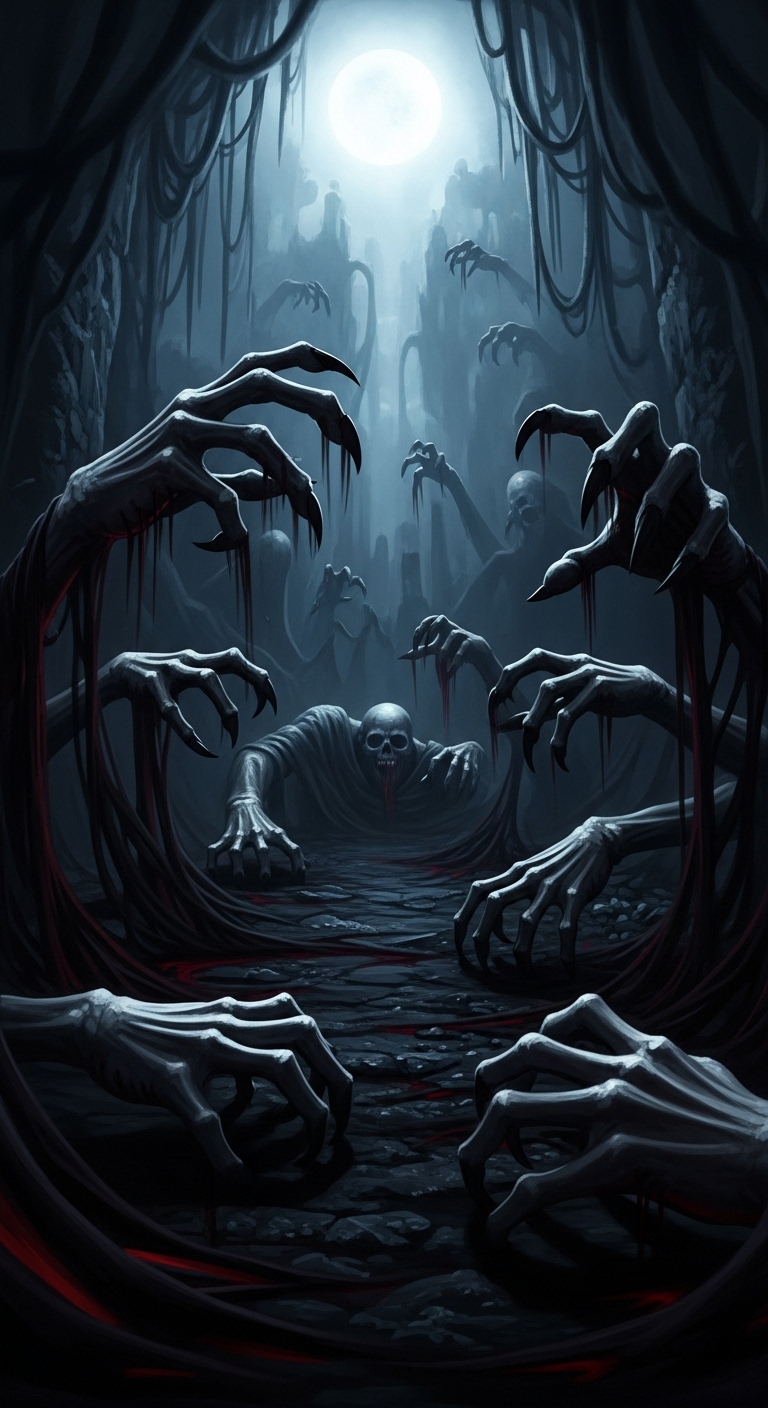Crawling Claw

Swarm of Crawling Claws
- Size: Medium
- Type: Swarm of Tiny Undead
- Alignment: Neutral Evil
- AC: 12
- Initiative: +2 (12)
- HP: 49 (11d8)
- Speed: 30 ft, Climb 30 ft .
| ATTR | VAL | MOD | SAVE |
|---|---|---|---|
| STR | 14 | +2 | +2 |
| Dex | 14 | +2 | +2 |
| Con | 11 | +0 | +0 |
| INT | 5 | -3 | -3 |
| Wis | 10 | +0 | +0 |
| CHA | 4 | -3 | -3 |
- Resistances: Bludgeoning, Piercing, Slashing
- Immunities: Necrotic, Poison; Charmed, Exhaustion, Frightened, Grappled, Incapacitated, Paralyzed, Petrified, Poisoned, Prone, Restrained, Stunned
- Senses: Blindsight 30 ft.; Passive Perception 10
- Languages: Understands Common but can't speak
- CR: 3 (XP 700; PB +2)
Traits
Swarm. The swarm can occupy another creature's space and vice versa, and the swarm can move through any opening large enough for a Tiny creature. The swarm can't regain Hit Points or gain Temporary Hit Points.
Actions
Swarm of Grasping Hands. Melee Attack Roll: +4, reach 5 ft . Hit: 20(4d8+2) Necrotic damage, or 11 (2d8+2) Necrotic damage if the swarm is Bloodied. If the target is a Medium or smaller creature, it has the Prone condition.
Lore & Background
Crawling claws are the severed hands of the dead, animated through necromantic magic to serve as scouts, spies, and assassins. These grotesque undead creatures retain some muscle memory from their former lives, making them surprisingly dexterous despite their limited form. They are typically created by necromancers who need small, inconspicuous servants that can perform delicate tasks or infiltrate areas where larger undead would be detected.
The creation of crawling claws requires both necromantic skill and access to fresh corpses, preferably from individuals who possessed notable manual dexterity in life. Thieves, artisans, musicians, and scribes often provide the best material for these creatures, as their hands retain muscle memory and fine motor control even after death. The animation process preserves some of the original owner's skills, making each crawling claw unique in its capabilities.
These creatures are often used for reconnaissance, theft, and assassination, as their small size allows them to move through spaces that would be impossible for humanoid agents. They can pick locks, manipulate objects, and even write messages, making them valuable tools for necromancers who need to operate covertly in civilized areas.
Combat Tactics
Crawling claws rely on stealth and surprise to be effective in combat, using their small size and ability to hide to position themselves for sneak attacks. They prefer to target vulnerable areas like necks, wrists, and ankles where their claws can do maximum damage to arteries and tendons. Their climbing ability allows them to attack from unexpected angles, dropping from ceilings or emerging from hiding spots.
These creatures work best in groups, coordinating their attacks to overwhelm single targets through sheer numbers. They use hit-and-run tactics, striking quickly before retreating to cover or hiding spots. Against armored opponents, they look for gaps in protection or attempt to remove helmets and other protective gear.
Crawling claws are particularly effective in environments with lots of cover and hiding spots, such as cluttered rooms, dense forests, or rocky terrain. They use their knowledge of the area to set up ambushes and create escape routes when the battle turns against them.
Encounter Ideas
The Necromancer's Spies: Crawling claws have been infiltrating a city, gathering information for their necromantic master and preparing for a larger undead assault.
The Haunted Manor: A noble's estate is plagued by crawling claws that were created from the hands of murdered servants, seeking revenge against their killer.
The Thieves' Tools: A criminal organization has acquired crawling claws to perform impossible heists, using their ability to fit through small spaces and manipulate locks.
The Plague of Hands: A curse has caused the recently buried dead to rise as crawling claws, creating a growing menace that threatens to overwhelm local authorities.
Environmental Effects
Unsettling Presence: Areas infested with crawling claws feel wrong and unnatural, with small objects frequently moving or disappearing without explanation.
Necromantic Taint: The presence of multiple crawling claws can create weak spots in the barrier between life and death, making other undead more likely to appear.
Disturbed Rest: Graveyards and burial sites affected by crawling claws become restless places where the dead cannot find peace.
Hidden Threats: The constant possibility of attack from small hiding spots creates an atmosphere of paranoia and unease.
Treasure
Stolen Goods: Items taken by the crawling claws during their activities, including coins, jewelry, keys, and small valuable objects.
Necromantic Components: The claws themselves can be harvested for use in creating other undead or for necromantic rituals and spells.
Hidden Caches: Crawling claws often hide their stolen goods in small, hard-to-reach places that can be discovered with careful investigation.
Personal Effects: Items that belonged to the original owners of the hands, which might provide clues about their identity or the circumstances of their death.
Plot Hooks
The Missing Hands: A series of grave robberies has left corpses missing their hands, and the crawling claws created from them are being used for a sinister purpose.
The Artisan's Curse: A master craftsman's hands were severed and animated after his death, and they're now creating cursed items that spread misfortune throughout the city.
The Spy Network: Crawling claws are being used to gather intelligence for a larger conspiracy, and stopping them requires tracking down their necromantic controller.
The Redemption Quest: The crawling claws were created from the hands of good people who deserve proper burial, and laying them to rest requires uncovering the truth about their deaths.